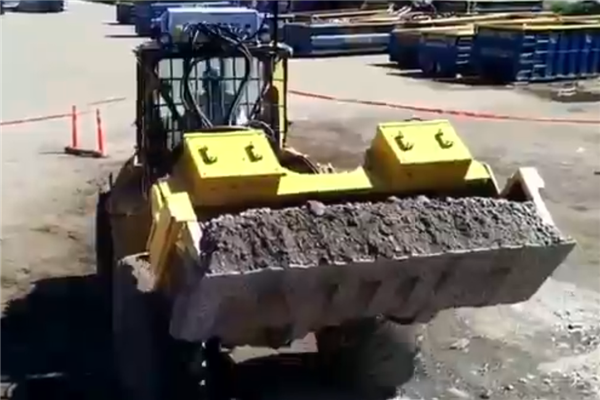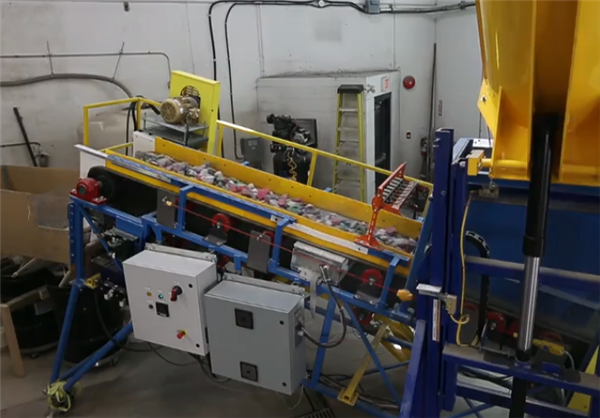Nevermind the machines how about paying attention to the minerals?

A front-end loader equipped with MineSense sensors. Note the large boxes above the bucket. Video still is from MineSense.
MineSense is carving out a niche by providing richer, real-time data looking at ore and waste that flows through a mine’s operations.
Andrew Bamber, CEO of the Vancouver-based mining supplier that was founded in 2008, says his company is unique in getting companies to more closely monitor minerals.
“[There] are probably 300 data points available around a typical truck or shovel at a mine site. Not one of those data points relate to the value of that asset being carried. We want to fix that through our technology,” says Bamber.
Investors are on board. The company closed a multi-million dollar Series B financing this spring. The company also has high profile backers. Ian Pearce, a partner with X2 Reslources, is board chairman at MineSense.
Pearce learned of the business when he was chief executive of Xstrata Nickel and Bamber paid him a visit. He was intrigued by the problem MineSense was solving.
“When you look at our industry, it is going to be challenged by two key things: energy and water. Instead of trying to solve the problems of downstream facilities [MineSense] was looking at the business and going right upstream and saying ‘How can I affect the energy equation?'”
Bamber and Pearce sat with MINING.com for an interview early this month:
MINING.com: What is MineSense?
CEO Andrew Bamber: MineSense technologies is a emerging mining technology company and we create sensor-based solutions for ore upgrading and waste trajection for typically large scale base metal mines, but we have an increased application for precious metal mines, as well.
MINING.com: What was the opportunity?
Bamber: It’s a perfect storm. It’s declining grades at established and new discoveries. It’s a combination of increasing cost; perhaps even hyperinflation in costs. It’s a combination of increased pricing, perhaps not low prices but certainly not high enough to sustain the cost level of mining. And an overall decline in productivity at mines over the last 15 years, which means that mines are in a terrible situation that the conventional ways of getting out of that in terms of trying to reach a new level of economy of scale or simply discovering your way out of that situation are not just available.
MINING.com: What is unique about the technology developed by your company?
Bamber: So we focused on the development of fast, robust, extended mineral sensors, which give us the ability those sensors physically into material handling equipment that mines have already invested in, for instance shovels and conveyor belts, where we can be deploying sensors, for instance on a shovel in an open pit bench or on a scoop in an underground stope situation by taking measurements of the actual quality of the ore real time, we can support what’s called online realtime ore control and ore routing support and improve decisions about the destination of that material without our technologies are simply operating to the plan. With the current levels of accuracy and precision of mine planning means there is tremendous both loss of value, as well as increases in cost due to the high amount of waste delivered to the mill process or the leach process that can actually be avoided.
MINING.com: It sounds like you generate a lot of data. How do you make that data actionable?
Bamber: There is a new generation of machines in play where there is intelligence on the machine for the operator. For instance, shovels with current mine planning and fleet management functionality on the machine. Not so much that the operator makes the decisions themselves, but the decision as to what to do with material that is just extracted is communicated to the operator. Our technology can just interface with directly with that system whether it is Cat’s MineStar or Komatsu’s Modular System. There is an interface point right on the shovel where we can affect that change.

MineSense technology deployed on a conveyor belt.
MINING.com: What’s the process for introducing a technology to miners?
Bamber: Typical sales process is long. We focus on a four-stage process, which is opportunity identification and testing, and estimating the value proposition of the value project, that is whether metrics are sufficiently strong for the customer. We would move into a trial, which is ideally customer funded. On successful conclusion of a trial—whether that is with the shovel technology or the sorter technology—we would then want to move into an implementation and commercial operation.
MINING.com: You have a PhD in mineral processing. What are the major trends in mineral processing? What are the changes that are happening to the industry?
Bamber: A few things are happening right now. Within mineral processing, there is ongoing incremental improvement of existing processes. But I think one of the biggest drives that we see. There has been a massive investment in what we call the SAG ball float flowsheet. And a lot of operators have realized the limitations of that flowsheet and want to move completely away from that where this is an alternative, such as high pressure griding, water free circuits, tumbling mill free circuits to get the energy quotient down. I think there is also tremendous investment—particularly amongst the bigger players like BHP, Anglos—to look at alternative processing altogether. Can you develop processes where you can go from extraction to smelting straight away? Can you go from extraction to leaching straight away and skip some of the more intermediate cost intensive processes?
MINING.com: Is there a mis-match between data from machinery and minerals?
Bamber: You are right. I often make the point in presentations that there are probably 300 data points available around a typical truck or shovel at a mine site. Not one of those data points relate to the value of that asset being carried. We want to fix that through our technology.
More News
{{ commodity.name }}
{{ post.title }}
{{ post.date }}

Comments
An Insider
I applaud any effort to get the mining industry to improve. That said, the mining industry is so far behind in terms of technology adoption, and especially in capable leaders this will be a hard slog for Bamber and Company. The title “Nevermind the machines…………” Well, first of all the mining industry has never cared for their productive assets and are so over capitalized which is a huge drag on their bottom line and profit margins. I know, I worked at all the big miners. Second, the things going on internally to these companies relative to the leadership and comedy of errors being played out is quite baffling. At a major mine in Rio Tinto they readily appoint people over 100’s of million of dollars in fleet who don’t have engineering degrees or understand how an internal diesel combustion engine works. At Rio Tinto’s and BHPB’s, and Anglo’s mines such a lack of discipline to follow and adhere to a mine plan is rampant. They don’t know what is in the ground or how to translate that into a workable plan and then execute it with precision and discipline. This is the failing of the mining industry, competent and capable people both leading and managing their operations. Execution at their operations are so poor they are in constant fire fighting mode and that includes chasing ore grades to boost up their output and revenues because of the failure occurring in the mines operations. Look at what happened at Kennecott with the mine wall collapse, that didn’t just happen overnight, the fault was know and managed for years except within the last 7 years, but all of the leaders who were there have since gone on to bigger promotions and took their merry band of brothers with them to create the same problems elsewhere. I could elaborate on BHPB and Anglo, and numerous others. Mining is a terrible investment for shareholders. Anyone of any capability that tries to improve the operations leaves. One thing that the mining industry is good on is window dressing or putting lipstick on a pig. They like to get PIP, McKinnsey, Proudfoot and the like into cut and slash the operations capability to save a few bucks so the leader can get his promotion and look like he/she is a hero. They all use the same recipe and are constantly forever going through this rollercoaster cycle of boom and bust. Like I said I have worked with the top echelons and the lowest managers in the operations at these companies and across most of their assets, they are so poorly lead, managed and operated I would never invest them. I am glad to be out of the game.